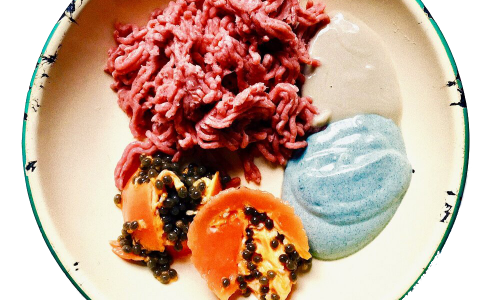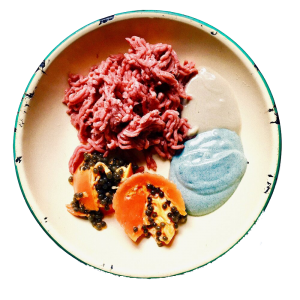Good-quality commercial and home-prepared diets offer certain advantages and disadvantages to dogs and their owners.
For many pet owners, the choice of whether or not to feed kibble to their pets on a daily basis is a no brainer. After all, kibble is affordable, convenient, and available in every variety imaginable. However, as humans gain better insight into the effects certain foods have on the health and wellbeing of their dogs, many pet owners are taking a closer look at food options and weighing the pros and cons of each food type.
The fact that the pet food industry has enjoyed such fantastic success is due to many factors. Many of us are too busy to shop and cook for ourselves, much less our dogs. Many people believe the slogans and promises printed in industry publications and on the food labels themselves, many have simply never questioned the fact that the food-making companies’ profits depend on convincing them that the commercial products are “best for dogs.”
An increasing number of pet owners have resorted to cooking human-grade meals for their pets in the wake of health and safety concerns regarding commercial pet food. For many pet owners, cooking their dogs’ food is an enjoyable experience that allows complete control over food quality, budget, and allergen elimination.
There are many advantages to feeding a dog the raw food diet, which consists primarily of raw, meaty bones, as well as a smaller percentage of supplementary fruit, vegetables, eggs, organ meat and other supplements. A primary advantage is that dogs prone to allergies particularly thrive on this diet because the majority of allergens such as soy, corn, wheat, and other grains are eliminated. Additionally, consumers have complete control over the ingredients and quality of the meat being purchased, which reduces the risk of a dangerous food recall. In comparison to other food types, the raw diet can lead to improved dental health, as chewing on bones naturally cleans teeth.
One of the biggest challenges in deciding whether to feed a raw diet is the overwhelming amount of conflicting information, and the fact that much of this information is anecdotal in nature. There are numerous websites and message boards praising the virtues of a raw diet and there are others condemning raw diets as unsafe and unhealthy. When choosing how and what to feed your dog, you need balanced information. This information should outline both the good and the bad so that an educated choice can be made.
When making the best choice for your dog, it’s important to remember that what is right for you and your dog may not be right for someone else and their dog. A raw diet may not be appropriate for all dogs and before the owner decides what is right for their dog, they should discuss the options with a veterinary or canine nutritionist.
Over the past couple of years, there have been a number of pet food recalls. When preparing your dog’s food at home, you have total control of what you include in your dog’s food and where those ingredients are from.
Raw diets (especially home-made diets) allow you to meet your dog’s specific needs. Raw diets can be prepared to avoid foods that your dog is allergic to and can be made to meet your dog’s specific nutrient requirements. Processed foods often have added preservatives that enhance product shelf life. Food that has been freshly prepared and has not been processed or had preservatives added is commonly considered a healthier choice.
There is no single type of food or type of preparation that will produce unblemished health in all dogs, just as there is no diet that suits all humans. The best food for a dog depends on its age, sex, breed, genetic inheritance, state of health, level of activity, geographic location, reproductive status, etc.
Not everyone has what it takes to organise a good diet for themselves; not every well-meaning dog owner has what it takes to successfully formulate a home-prepared diet for their dogs, either.
Some dogs are probably better off with a commercial diet. If a person doesn’t have the time, resources, and interest in preparing a “complete and balanced” homemade diet for their dogs, or if a dog doesn’t seem to thrive on the homemade diet his owner has provided for him, he undoubtedly has better prospects on a top-quality commercial food. Or even a well-considered mixture of the two.
Promoting health and wellness in dogs and cats is a common goal for veterinarians and pet owners alike. Over the past decade, a number of highly publicized pet food recalls, as well as a growing awareness of the role of diet in health and disease for people, have changed the way some owners approach mealtime for their pets. Many owners, and some veterinarians, now advocate feeding dogs and cats home-prepared foods (raw, cooked, or both) as the sole source of nutrition for pets and cite either perceived health benefits or a general mistrust of the pet food industry as the reason.
It seems like every day brings a new dog food recall, so it’s understandable to want to do everything possible to ensure that your dog’s diet is as safe and nutritious as possible.
After multiple recalls of several varieties of Hill’s dog food during 2019, the root cause of the problem was traced to a vitamin premix product. As of three months ago, the FDA remained unconvinced that Hill’s had resolved all the issues that contributed to the vitamin D toxicity problem. With contamination and nutrient issues with highly processed pet food continuing into the foreseeable future, the safest option for concerned pet parents is preparing pet meals themselves using ingredients they choose or feeding nutritionally dense, fresh food diets manufactured by one of the many innovative, new and transparent pet food companies entering the market.
Whether your dog has specific dietary restrictions or you are worried about poor-quality ingredients or possible contaminants, having greater control over which ingredients are included in your dog’s diet can bring peace of mind. It’s becoming much easier to find pet foods made with ethically sourced, non-GMO ingredients, humanely slaughtered meats, third party quality control testing for heavy metals and contaminants, and recipes formulated for optimal nutrient composition via real, living foods.










